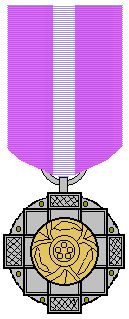Padma Bhushan
Padma Bhushan is the third-highest civilian award in the Republic of India, following the Bharat Ratna and the Padma Vibhushan but coming before the Padma Shri. It is announced on the occasion of Republic Day of India every year. The award is given for "distinguished service of a high order...without distinction of race, occupation, position, or sex." The award criteria include "service in any field including service rendered by Government servants," but it does not include those working with the Public Sector Undertakings. The recommendations for the Padma Bhushan are made by the Padma Awards Committee, which is constituted by the Prime Minister every year.
History[edit | edit source]
The Padma Bhushan was established on January 2, 1954, by the President of India. It was created to recognize distinguished service of a high order in any field, including service rendered by Government servants. The awards were initially divided into three categories: Pahela Varg, Dusra Varg, and Tisra Varg, which were later changed to Padma Vibhushan, Padma Bhushan, and Padma Shri in 1955.
Award Process[edit | edit source]
The process of nomination and selection of the awardees is carried out annually. Recommendations are received from various sources such as state governments, central government ministries, departments, Bharat Ratna and Padma Vibhushan awardees, and Institutes of Excellence. These recommendations are then reviewed by the Padma Awards Committee, which is appointed by the Prime Minister. The committee's recommendations are submitted to the Prime Minister and the President for approval. The recipients are announced on the eve of Republic Day, and the awards are distributed at a ceremony held at the Rashtrapati Bhavan sometime around March or April.
Design[edit | edit source]
The Padma Bhushan medal is made of bronze and is embossed with a lotus flower. The awardee's name is engraved on the reverse side of the medal. The ribbon is of a pattern of red and white.
Notable Recipients[edit | edit source]
Over the years, the Padma Bhushan has been awarded to individuals across various fields including arts, literature, sports, medicine, social work, science and engineering, public affairs, civil service, and trade and industry. Notable recipients include:
- C.N.R. Rao, a renowned scientist in the field of solid-state and structural chemistry. - Viswanathan Anand, five-time World Chess Champion. - Ratan Tata, prominent industrialist and former chairman of Tata Group. - Amitabh Bachchan, celebrated actor in the Indian film industry. - M.S. Subbulakshmi, a legendary Carnatic vocalist.
Controversies[edit | edit source]
Like any high-profile award, the Padma Bhushan has had its share of controversies and criticisms. Some have questioned the selection criteria, alleging biases and political influence in the selection process. Others have declined the award, citing personal reasons or dissatisfaction with the selection process.
Conclusion[edit | edit source]
The Padma Bhushan stands as a testament to the Indian government's recognition of exceptional service and achievements in various fields. Despite the controversies, it remains one of the most prestigious awards in India, celebrating the contributions of individuals to the nation and society.
| This article is a stub. You can help WikiMD by registering to expand it. |
Search WikiMD
Ad.Tired of being Overweight? Try W8MD's physician weight loss program.
Semaglutide (Ozempic / Wegovy and Tirzepatide (Mounjaro / Zepbound) available.
Advertise on WikiMD
|
WikiMD's Wellness Encyclopedia |
| Let Food Be Thy Medicine Medicine Thy Food - Hippocrates |
Translate this page: - East Asian
中文,
日本,
한국어,
South Asian
हिन्दी,
தமிழ்,
తెలుగు,
Urdu,
ಕನ್ನಡ,
Southeast Asian
Indonesian,
Vietnamese,
Thai,
မြန်မာဘာသာ,
বাংলা
European
español,
Deutsch,
français,
Greek,
português do Brasil,
polski,
română,
русский,
Nederlands,
norsk,
svenska,
suomi,
Italian
Middle Eastern & African
عربى,
Turkish,
Persian,
Hebrew,
Afrikaans,
isiZulu,
Kiswahili,
Other
Bulgarian,
Hungarian,
Czech,
Swedish,
മലയാളം,
मराठी,
ਪੰਜਾਬੀ,
ગુજરાતી,
Portuguese,
Ukrainian
Medical Disclaimer: WikiMD is not a substitute for professional medical advice. The information on WikiMD is provided as an information resource only, may be incorrect, outdated or misleading, and is not to be used or relied on for any diagnostic or treatment purposes. Please consult your health care provider before making any healthcare decisions or for guidance about a specific medical condition. WikiMD expressly disclaims responsibility, and shall have no liability, for any damages, loss, injury, or liability whatsoever suffered as a result of your reliance on the information contained in this site. By visiting this site you agree to the foregoing terms and conditions, which may from time to time be changed or supplemented by WikiMD. If you do not agree to the foregoing terms and conditions, you should not enter or use this site. See full disclaimer.
Credits:Most images are courtesy of Wikimedia commons, and templates, categories Wikipedia, licensed under CC BY SA or similar.
Contributors: Prab R. Tumpati, MD

